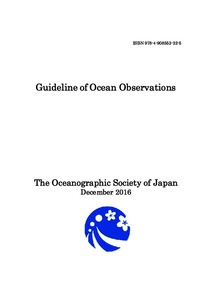| dc.contributor.editor | Kawano, Takeshi | |
| dc.date.accessioned | 2018-06-30T22:55:12Z | |
| dc.date.available | 2018-06-30T22:55:12Z | |
| dc.date.issued | 2016 | |
| dc.identifier.citation | Takawano, T. (ed) (2016) Guideline of ocean observations. 1st edition.. [Vols 1-10]. Tokyo, Japan, The Oceanographic Society of Japan, 384pp. DOI: http://dx.doi.org/10.25607/OBP-28 | en_US |
| dc.identifier.isbn | 978-4-908553-32-5 | |
| dc.identifier.uri | http://hdl.handle.net/11329/442 | |
| dc.identifier.uri | http://dx.doi.org/10.25607/OBP-28 | |
| dc.description.abstract | In recent years we have been building our knowledge of changes within the oceans
through international cooperation and collaboration, for example, by re-occupation of
World Ocean Circulation Experiment (WOCE); our findings were cited in the Fifth
Assessment Report from the IPCC. To implement plans to make all measurement values
used in climate change research completely SI-traceable, the General Conference on
Weights and Measures has been providing advice to relevant institutions. Through
measures such as promulgating the use of standard materials
for nutrients, we are making progress in comparability of data, research that depends on this comparability,
and R&D on standard materials.
However, the guidelines used for measurement and analysis do not seem to be
keeping up with this progress. The Oceanographic Observation Guidelines published by
the Japan Meteorological Agency in 1999 are relatively widely used in Japan, but their
content is not always completely up-to-date and the Guidelines are now quite hard to
obtain. In 2010, the WOCE Manual was revised and published as the GO-SHIP
Oceanographic Observation Manual (IOCCP Report No.14, 2010), but this is principally for repeat hydrography in the open ocean; it was not intended to guide a wide range of users. There are a number of other manuals and guidelines available but
some of them are only written in Japanese, whereas others are only written in English; moreover, they mix together up-
to-date content and less up-to-date content. In this context, the Oceanographic Society of Japan (JOS) has decided to set up an
editorial committee for oceanographic observation guidelines, to review
and collate the various existing guidelines, and to incorporate necessary revisions and fill in any gaps.
We will publish Oceanographic Observation Guidelines describing the most up-to-date oceanographic observation methods and analytical techniques, and we will make these new guidelines available through the JOS website | en_US |
| dc.language.iso | en | en_US |
| dc.publisher | The Oceanographic Society of Japan | en_US |
| dc.subject.other | Quality control | en_US |
| dc.subject.other | Reference materials | en_US |
| dc.subject.other | Standard materials | en_US |
| dc.subject.other | Seawater analysis | en_US |
| dc.subject.other | Plankton | en_US |
| dc.subject.other | Benthos | en_US |
| dc.subject.other | Sediment analysis | en_US |
| dc.title | Guideline of ocean observations. 1st edition. [Vols 1-10].[SUPERSEDED by DOI: http://dx.doi.org/10.25607/OBP-772] | en_US |
| dc.type | Report | en_US |
| dc.description.status | Published | en_US |
| dc.format.pages | 384pp. | en_US |
| dc.description.notes | Some chapters are still in preparation. 2nd edition under construction | en_US |
| dc.description.refereed | Refereed | en_US |
| dc.publisher.place | Tokyo, Japan | en_US |
| dc.subject.parameterDiscipline | Parameter Discipline::Physical oceanography | en_US |
| dc.subject.parameterDiscipline | Parameter Discipline::Chemical oceanography | en_US |
| dc.subject.parameterDiscipline | Parameter Discipline::Biological oceanography | en_US |
| dc.subject.parameterDiscipline | Parameter Discipline::Marine geology | en_US |
| dc.description.currentstatus | Superseded | en_US |
| dc.description.bptype | Standard Operating Procedure | en_US |
| dc.description.bptype | Guide | en_US |
| obps.resourceurl.publisher | http://kaiyo-gakkai.jp/jos/en/guide/download | en_US |
 Repository of community practices in Ocean Research, Applications and Data/Information Management
Repository of community practices in Ocean Research, Applications and Data/Information Management
